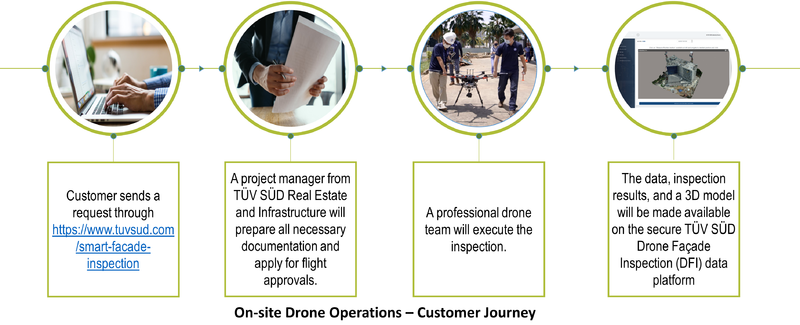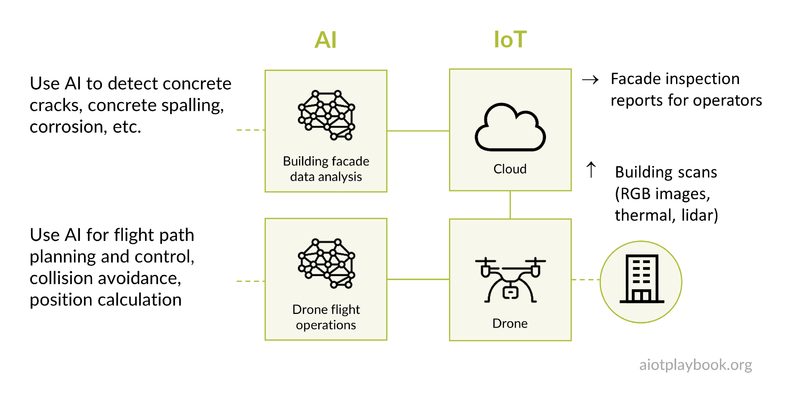Introduction
This case study describes a drone-based system for automated building facade inspection which is utilizing AIoT for drone management and image-analytics. The system is developed by the Real Estate & Infrastructure Division of TÜV SÜD.
Building facades are an important aspect of buildings, both from an architectural as well as from an engineering perspective. The building facade not only has a huge impact on aesthetics, but also on energy efficiency and safety. Especially in high-rise buildings, the facade can be quite complex, combining a number of different materials, including concrete, glass, steel, polymers and complex material mixes.
Problems with building facades can arise during construction as well as during the building operations phase. Typical problems include cracks in different materials, concrete spalling, corrosion, delamination, decolorization, efflorescence, peeling and flaking, chalking, hollowness, sealant deterioration, and so on. While some of these problems only have an impact on the optics of the buildings, others can have a quite severe impact on safety, e.g. because of facade elements falling down from high heights, increased risk of fires, or even complete collapses.
Facade Inspection
Façade inspection is an integral part of building maintenance, especially for high-rise buildings. It helps to verify the integrity of the building structure and ensures safety for its occupants and people passing by. However,conventional manual facade inspection can be time, labor and cost intensive, as well as disruptive for the building occupants, and dangerous for inspector due to difficult access at height. Finally, the results of manual facade inspection can be subjective, depending on the expertise of the inspector.
In some countries, regular facade inspections are required by regulators. Regulations usually differ, depending on building size and age. For example, in Singapore buildings older than 20 years old and over 13 meters in height have to undergo facade inspections every 7 years. In other countries, the requirements for periodic facade inspections are more driven by building insurance companies.
Automated Facade Inspection
Automated facade inspection solutions must accurately scan the exterior of buildings, e.g. utilizing drones to carrying high-resolution cameras. The Smart Façade Inspection service of TUEV SUED caters to building owners and operators of large high-rise buildings and helps construction companies to ensure façade quality and monitor construction progress.
Customer Journey
The customer journey of the automated facade inspection solution starts with the customer request for the service. Based on the customer information provided, the service operator (TUEV SUED) will preparare the required documentation and apply with the required authorities for drone fligh approvals. The inspection on-site will be carried out by a specialized drone operations team. The data, inspection results and a 3D model of the facade will be made available via a specialized cloud platform.
Customer Benefits
Customer benefits include:
- Results are available in a fraction of the time compared to conventional inspection
- Digital representation of the facade and whole building facilitates building operation
- Automated digital workflow and data benchmarking improve service quality and interoperability
- Domain experts for standards and best practice, ensuring up-to-date compliance to continually evolving regulations
TBD: Multi-purpose use of information
Implementation with AIoT
At the core of the operational system is a smart piloting system for the drone, which ensures both operational safety and high-quality visual inspection. The acquired data is securely managed by TÜV SÜD’s inspection platform, which automatically masks any private information to protect your privacy
The AI-based solution assists professional engineers to deliver compliant inspection reports at the highest industry standard. The software constructs a 3D model of the building façade, which helps to better understand the building structure and automatically locate the detected defects on the building.
The TUEV SUED Drone Façade Inspection application provides access to all the data, report findings, and 3D model at any time. Repairs and follow-ups can be seamlessly managed through the platform to improve efficiency and save costs.
Solution Sketch
Main stakeholders for operations of the drone in the field include the drone pilot, safety offiver, and domain expert. Professional engineers are supporting in the backend. Customer stakeholders include building owners, facility managers, and regulators.
The drone is equipped with a number of sensors to support both, flight operations and building facade scanning. These flight support sensors include IMU, UWB, Lidar and stereo camera. The drone carries thermal sensors and a visual camera as the main payload for building facade data capturing. On the drone, AI is mainly used for drone positioning, collision avoidance and path planning. This is supported by a smart controller device used by the drone pilot on the ground.
A number of backend applications are supporting the management, processing, anlysis and visualization of the captured data. Domain experts and professional engineers can add their domain expertise as well.
Drone control
A key feature of the solution is the advanced drone control, which provides semi-automated path control for scanning the building surface, supporting complex urban environments. Multi-modal sensor fusion is used for navigation. Auto path-planning supports inspection & obstacle avoidance, operational safety of the drone, and ensures high-quality image capturing for the visual inspection.
To support this, the drone carries a miniature, high-performance Inertial Measurement Unit (IMU) and Attitude Heading Reference System (AHRS). The Lidar sensor provides stereo data for dense short range on path obstacle detection (30m). The system also has two stereo cameras for sparse long-range obstacle detection (120m).
Drone data analysis: Facade Inspection
Another key application of AI is the drone data analysis, which is used for creating the facade inspection reports. First, the raw facade data is pre-processed, e.g. anonymizing the captured data. Second, an AI-enhanced image analysis tool is applied to visual and thermal data. Finally, the meta-data is anylyed, utilizing AI to identify individual facade elements, different types of defects, and even detailed defect attributes.




